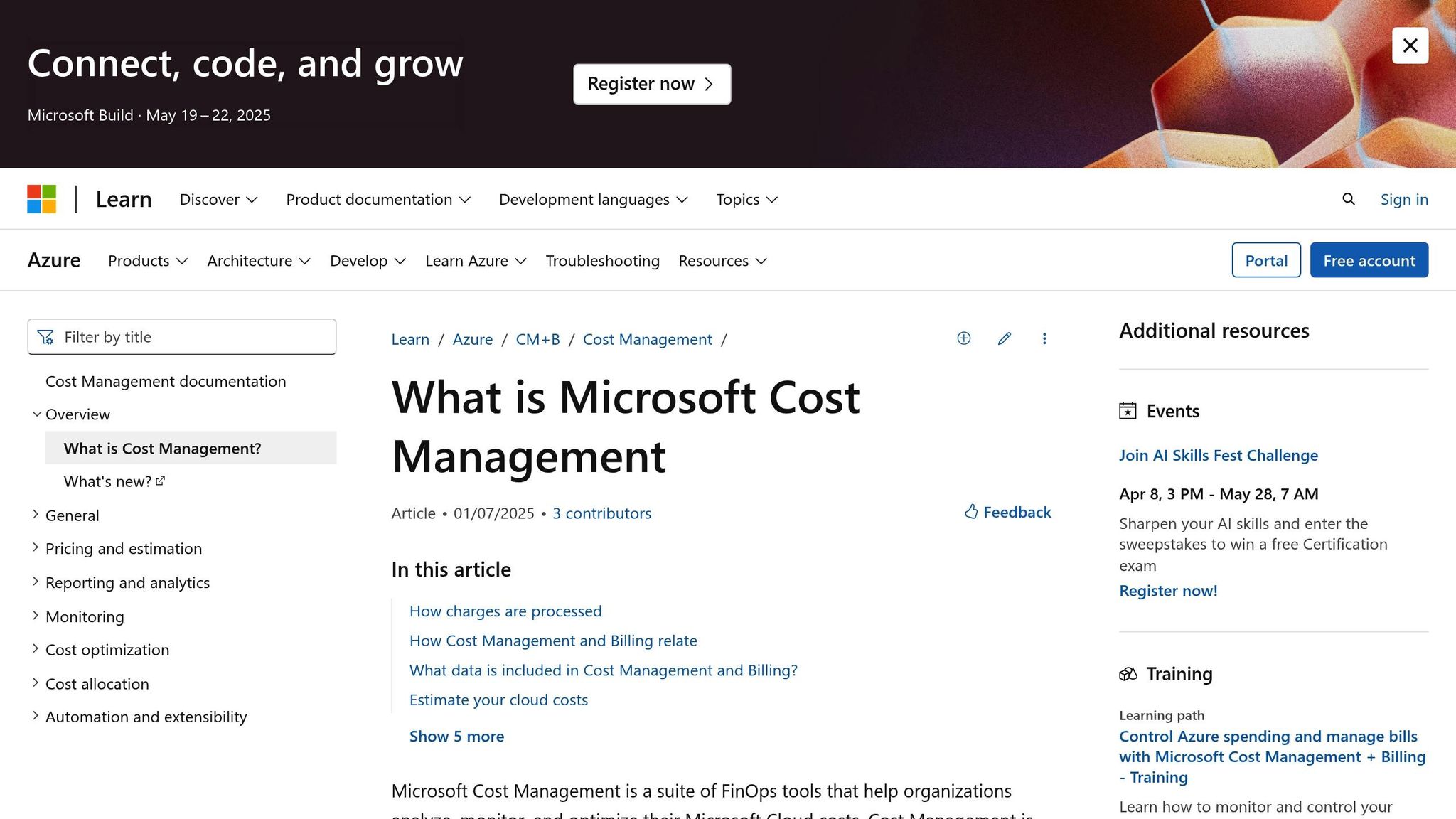Azure Cost Management Checklist for IT Managers
Learn effective strategies to manage and optimize Azure costs, ensuring your cloud expenses align with your budget and business goals.

Managing Azure costs can save your business thousands. Here’s how you can cut expenses while staying efficient:
- Use Cost-Saving Tools: Azure Hybrid Benefit can reduce Windows Server and SQL Server costs by up to 85%. Reserved Instances save up to 72% compared to pay-as-you-go.
- Track Spending Real-Time: Use Azure Cost Management (free) to monitor, analyse, and optimise your cloud expenses.
- Set Budgets and Alerts: Avoid overspending by setting spending limits and receiving alerts when nearing budget thresholds.
- Identify Unused Resources: Deallocate idle virtual machines, orphaned disks, and unused storage.
- Optimise Resources: Resize over-provisioned resources and schedule shutdowns for non-production environments.
Quick Comparison of Azure Cost-Saving Options

| Option | Savings Potential | Best For | Commitment Period |
|---|---|---|---|
| Azure Hybrid Benefit | Up to 85% | Windows/SQL workloads | Flexible |
| Reserved Instances | Up to 72% | Predictable workloads | 1–3 years |
| Azure Savings Plan | Up to 65% | Flexible compute needs | 1–3 years |
| Serverless Computing | Pay-per-execution | Event-driven, variable workloads | None |
Start saving today by using these strategies and tools to keep your Azure costs under control.
Azure Cost Optimization Deep Dive
Azure Billing Basics
Understanding Azure billing is key to managing cloud expenses effectively.
Azure Payment Options
Azure provides flexible payment options to suit various business requirements. The pay-as-you-go model allows access to all Azure services without any upfront commitment. New customers can also benefit from a free account, which includes £160 in credits for 30 days and 12 months of free access to popular services.
For businesses looking to save more, there are commitment-based plans:
| Payment Model | Savings Potential | Commitment Period |
|---|---|---|
| Azure Savings Plan | Up to 65% | 1 or 3 years |
| Reserved Instances | Up to 72% | 1 or 3 years |
| Azure Hybrid Benefit | Up to 36% (Windows Server) | Flexible |
To manage costs effectively, it's important to understand the details of your Azure bill.
Reading Azure Bills and Reports
Azure bills include several components that IT managers should review:
- Rated Usage: Lists the amount and cost of each service used.
- Applied Discounts: Reflects any discounts based on your pricing agreement.
- Credits: Deducted before the final invoice is generated.
- VAT: Calculated according to UK tax regulations.
The Microsoft Cost Management tool is invaluable for analysing spending patterns. However, note that some elements - such as credits, taxes, and certain support charges for non-Microsoft Customer Agreement accounts - aren't shown in the Cost Management view.
Planning Azure Spending
Strategic planning is crucial for managing Azure costs. Use Azure's forecasting tools to estimate future expenses based on current usage, and the Azure pricing calculator to anticipate costs for new workloads.
Here are some effective strategies:
- Resource Organisation: Use billing profiles and invoice sections to track spending across departments accurately.
- Cost Monitoring: Regularly review costs with Azure Cost Management and set up alerts for spending limits.
- Resource Tagging: Assign tags to resources to clarify costs and ensure proper allocation.
The Azure Well-Architected Framework offers further advice on balancing cost management with operational needs. Regularly reviewing cost allocation ensures spending aligns with business goals.
Next, learn about tools for tracking and managing costs in real time.
Cost Tracking Tools
Use Azure Cost Management to create custom views, analyse spending patterns, and automate reports.
Azure Cost Management Setup

Azure Cost Management is free to use via the Azure portal and provides detailed insights into your cloud expenses. Cost data is processed within 8–24 hours.
- Customise Cost Views: Break down spending by department, project, resource, or service usage.
- Analyse Costs: Review historical trends, resource usage, service-specific spending, and forecast future expenses.
- Automate Reports: Schedule daily summaries, weekly trends, monthly budget checks, and quarterly forecasts.
Once configured, you can take it further by setting up budgets and alerts to avoid overspending.
Budget and Alert Configuration
Managing budgets effectively requires proactive alerts. Azure's tools let you set thresholds and receive notifications before exceeding your limits.
| Alert Type | Purpose | Trigger Point |
|---|---|---|
| Budget Alerts | Keep track of overall spending | When spending nears or exceeds limits |
| Credit Alerts | Monitor prepayment balances | When Azure credits are used up |
| Anomaly Alerts | Spot unusual spending patterns | When costs deviate from the norm |
Steps to set up budget monitoring:
- Create budgets at the subscription or resource group level.
- Choose reset periods (monthly, quarterly, or annually).
- Set alerts for actual and forecasted spending.
- Add up to five email recipients for notifications.
- Ensure azure-noreply@microsoft.com is whitelisted for email delivery.
Cost Tags and Labels
Tags help you track spending more precisely by categorising resources.
| Tag Category | Purpose | Example Values |
|---|---|---|
| Business Unit | Attribute costs to departments | Finance, Marketing, IT |
| Environment | Separate environments | Prod, Dev, Test |
| Cost Centre | Link to accounting codes | 55332, 55333 |
| Workload Name | Identify specific services | ControlCharts, PayrollSystem |
| Operations Team | Assign accountability | Central IT, Cloud Ops |
Best practices for tags:
- Apply tags consistently across all resources.
- Use Azure Policy to maintain tagging standards.
- Review and update tags quarterly.
- Adjust tags when resource ownership changes.
Cost Reduction Methods
Cut down on Azure costs by getting rid of unnecessary expenses.
Finding Unused Resources
Regular audits can help identify idle resources that are no longer needed.
| Resource Type | Detection Method | Action Required |
|---|---|---|
| Virtual Machines | CPU usage < 5%, network < 7 MB for 4+ days | Deallocate or downsize |
| Storage Accounts | No access in past 7 days | Archive or delete |
| Orphaned Disks | Unattached to VMs | Remove if unnecessary |
| Legacy Components | Outdated workloads | Modernise or decommission |
Key steps to take:
- Use Azure Advisor to identify idle resources.
- Review flagged inactive resources monthly.
- Maintain a cloud governance checklist for better resource management.
Once you've addressed unused resources, focus on resizing to optimise further.
Resource Size Adjustment
Azure Advisor can suggest ways to optimise resources based on performance data.
| Current State | Recommended Action | Potential Impact |
|---|---|---|
| Over-provisioned VMs | Downsize to an appropriate tier | Lower operating costs |
| Variable Workloads | Switch to burstable SKUs | Cost-effective scaling |
| Development Resources | Schedule auto-shutdown | Reduced off-hours expenses |
Reserved and Serverless Options
For predictable workloads, Reserved Instances can lower costs significantly, while serverless options like Azure Functions are ideal for variable workloads.
| Option Type | Best For | Savings Potential |
|---|---|---|
| Reserved Instances | Steady, predictable workloads | Up to 72% vs pay-as-you-go |
| Azure Savings Plan | Dynamic compute needs | Up to 65% savings |
| Azure Hybrid Benefit | Windows/SQL workloads | Up to 80% with RIs |
| Serverless Computing | Event-driven tasks | Pay per execution |
Actions to consider:
- Evaluate workload patterns to decide on Reserved Instances.
- Use Azure Savings Plan for flexible compute requirements.
- Apply Azure Hybrid Benefit to cut costs on Windows/SQL workloads.
- Opt for serverless computing for tasks that run intermittently.
"Save up to 65 percent off pay-as-you-go pricing when you commit to spend a fixed hourly amount on compute services for one or three years." - Microsoft
Budget Planning and Reports
Once you've got cost tracking tools in place, the next step is planning budgets and creating detailed reports to manage your Azure expenses effectively.
Usage-Based Cost Estimates
Analyse past usage patterns to predict future costs. Azure updates cost data within 8–24 hours, and budgets are evaluated daily.
| Time Period | Forecast Basis | Evaluation Frequency |
|---|---|---|
| Monthly | Past 30 days | Every 24 hours |
| Quarterly | Past quarter | Every 24 hours |
| Annual | Past fiscal year | Every 24 hours |
To refine your forecasts, consider:
- Applying filters to focus on specific resource groups or services
- Setting budget reset intervals (monthly, quarterly, or annually)
- Specifying end dates for budget validity
- Setting up alerts for actual and projected costs
These steps help you set clear and actionable budget limits.
Cost Reports in GBP
Azure cost reports are displayed in £, offering three main reporting options:
| Reporting Method | Best Used For | Key Features |
|---|---|---|
| Cost Analysis | Quick insights | Ad-hoc exploration and lightweight analytics |
| Power BI | In-depth analysis | Custom dashboards and data integration |
| Scheduled Exports | Routine updates | Automated delivery and API integration |
You can schedule alerts daily, weekly, or monthly to monitor spending patterns. After reviewing reports, compare Azure pricing models to find opportunities for cost optimisation.
Cost Method Comparison
Evaluate Azure's pricing models to better align your spending with your needs:
| Pricing Model | Commitment Period | Potential Savings | Best For |
|---|---|---|---|
| Pay-as-you-go | None | Baseline cost | Unpredictable workloads |
| Reserved Instances | 1–3 years | Up to 72% | Consistent usage |
| Azure Savings Plan | 1–3 years | Up to 65% | Flexible compute needs |
| Hybrid Benefit | Varies | Extra savings | Windows/SQL workloads |
To cut costs further:
- Use Azure Advisor's tailored recommendations
- Tag resources systematically for better tracking
- Regularly review resource usage and adjust sizes as needed
- Optimise non-production environments by considering trade-offs
Keep in mind that Microsoft Cost Management is free to use, making it a practical solution for businesses of all sizes to monitor and manage Azure expenses effectively.
Resources and Updates
Azure Cost Guides
Microsoft offers a range of tools to help manage Azure expenses effectively, all available at no extra charge. Key among these are the Azure Well-Architected Framework and Azure Advisor. These tools are designed to assist IT managers with both project planning and day-to-day expense tracking.
Here are some of the most useful resources:
| Resource | Purpose |
|---|---|
| Azure Pricing Calculator | Estimating project costs |
| TCO Calculator | Comparing migration expenses |
| Azure Policy | Enforcing compliance and cost controls |
| Cost Management + Billing | Monitoring and managing expenses |
These tools are particularly helpful for small and medium-sized businesses (SMBs) looking to run Azure environments efficiently without incurring extra costs. It’s also important to ensure that your cost-saving strategies comply with UK regulations.
UK Compliance Rules
Managing Azure costs in the UK requires a balance between cost efficiency and adherence to strict compliance standards. Azure Policy provides built-in initiatives that align with UK OFFICIAL and NHS requirements, ensuring organisations remain compliant while optimising costs.
Here are some key compliance requirements and their cost implications:
| Requirement | Implementation | Cost Impact |
|---|---|---|
| Data Protection | Use HTTPS for data in transit | Minimal additional cost |
| Access Control | Enable multi-factor authentication | Included in most licences |
| Resource Protection | Apply network security groups | Built into the service |
| Audit Logging | Configure SQL server auditing | Storage costs may vary |
To stay compliant while managing costs:
- Enable Azure Policy’s compliance controls.
- Perform regular vulnerability scans.
- Set up disaster recovery for critical systems.
- Use DDoS Protection for sensitive workloads.
You can also lower costs by using storage tiering. Move less frequently accessed data to lower-cost storage tiers without compromising regulatory compliance. Regularly checking Azure Advisor recommendations can further highlight areas for cost savings.
Summary
This section pulls together the key actions needed to manage Azure costs efficiently. Keeping Azure costs under control requires ongoing monitoring and adjustments across both technical and organisational areas.
Azure offers tools that can help cut expenses significantly. For example, Reserved Instances can reduce costs by up to 72%, and the Azure Hybrid Benefit provides additional savings for Windows Server and SQL Server users. Below is a breakdown of the main steps for effective cost management:
| Key Focus Areas | Actions to Take | Benefits |
|---|---|---|
| Daily Monitoring | Check daily spend, prepaid balances, and usage patterns | Spot cost anomalies early |
| Resource Management | Remove unused resources and adjust sizes of current ones | Lower total cost of ownership (TCO) |
| Billing Alignment | Match resource usage to billing increments and review pricing tiers | Better cost predictability |
| Team Training | Provide regular training and set accountability measures | Strengthen financial awareness |
"What's important today might not be important tomorrow." - Microsoft Azure Well-Architected Framework
Stay cost-efficient by automating alerts, reviewing subscriptions frequently, and making deliberate choices in nonproduction environments. Regular evaluations and flexible updates ensure your Azure setup continues to meet changing needs effectively.
FAQs
How can I use Azure Hybrid Benefit and Reserved Instances to cut costs on Azure services?
Azure Hybrid Benefit helps you save on Azure costs by allowing you to use your existing on-premises Windows Server and SQL Server licences with Software Assurance. This can reduce Azure compute costs by up to 40–50%, making it an excellent option for businesses looking to optimise their budgets.
When combined with Azure Reserved Instances, which offer discounts of up to 72% compared to pay-as-you-go pricing, the savings can be even greater. For long-term workloads, the combination of these two strategies can lead to cost reductions of up to 80%. Reserved Instances are ideal for predictable workloads, as they let you commit to one- or three-year terms at significantly lower rates.
By leveraging these tools effectively, SMBs can maximise their Azure investment while keeping cloud expenses under control.
How can I set up budget alerts in Azure Cost Management to avoid overspending?
To prevent overspending in Azure, you can create budget alerts that notify you when your costs approach or exceed predefined thresholds. These alerts can monitor both actual spending and forecasted costs, helping you stay within your budget.
Set up notifications to be sent via email or push alerts whenever your spending reaches a specific percentage of your budget. Forecasted alerts are particularly useful as they provide early warnings if your current spending trends are likely to surpass your budget. This allows you to take proactive steps to adjust resource usage or reallocate funds as needed.
By using budget alerts effectively, you can maintain better control over your Azure costs and ensure your cloud expenses align with your financial plans.
How can I identify and manage unused Azure resources to reduce costs effectively?
To reduce costs, start by identifying and managing unused or underutilised resources in Azure. Use Azure Advisor to review recommendations for resizing, shutting down, or decommissioning virtual machines and other resources that show low CPU usage or minimal network activity over time. Audit your Azure environment regularly to pinpoint idle or unnecessary resources.
Additionally, tools like Azure Monitor can help you track resource activity, such as storage account transactions, to determine whether they are actively in use. By consistently reviewing and optimising your resource allocation, you can significantly reduce unnecessary expenses and improve cost efficiency.




